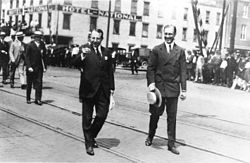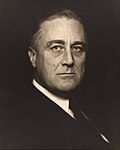Franklin D. Roosevelt
Franklin Delano Roosevelt (January 30, 1882 – April 12, 1945) was the 32nd president of the United States from 1933 to his death. He died shortly after he he had begun his fourth term. The twelve years in the office was the longest ever spent in it. After his death, the 22nd Amendment came into effect and set term limits to prevent another person from being president that long.
Franklin D. Roosevelt | |||||||||
|---|---|---|---|---|---|---|---|---|---|
 Official presidential portrait of Franklin D. Roosevelt | |||||||||
| 32nd President of the United States | |||||||||
| In office March 4, 1933 – April 12, 1945 | |||||||||
| Vice President |
| ||||||||
| Preceded by | Herbert Hoover | ||||||||
| Succeeded by | Harry S. Truman | ||||||||
| 44th Governor of New York | |||||||||
| In office January 1, 1929 – December 31, 1932 | |||||||||
| Lieutenant | Herbert H. Lehman | ||||||||
| Preceded by | Al Smith | ||||||||
| Succeeded by | Herbert H. Lehman | ||||||||
| Assistant Secretary of the Navy | |||||||||
| In office March 17, 1913 – August 26, 1920 | |||||||||
| President | Woodrow Wilson | ||||||||
| Preceded by | Beekman Winthrop | ||||||||
| Succeeded by | Gordon Woodbury | ||||||||
| Member of the New York Senate from the 26th district | |||||||||
| In office January 1, 1911 – March 17, 1913 | |||||||||
| Preceded by | John F. Schlosser | ||||||||
| Succeeded by | James E. Towner | ||||||||
| Personal details | |||||||||
| Born | Franklin Delano Roosevelt January 30, 1882 Hyde Park, New York, U.S. | ||||||||
| Died | April 12, 1945 (aged 63) Warm Springs, Georgia, U.S. | ||||||||
| Cause of death | Cerebral hemorrhage | ||||||||
| Resting place | Springwood Estate Hyde Park, New York, U.S. | ||||||||
| Political party | Democratic | ||||||||
| Height | 1.88 m (6 ft 2 in) | ||||||||
| Spouse(s) | |||||||||
| Children | 6 | ||||||||
| Parents | |||||||||
| Relatives | |||||||||
| Education | Harvard University (BA) Columbia University (JD) (posthumous, 2008) | ||||||||
| Signature | |||||||||
| |||||||||
Before becoming president, he was governor of New York from 1929 to 1932, assistant United States Secretary of the Navy from 1913 to 1920, and New York state senator from 1911 to 1913. He was a member of the Democratic Party.
Family
His father, James Roosevelt I, and his mother, Sara Delano, were from rich old New York families, which had made money from slavery.[1][2] The Roosevelts were originally from the Netherland, and the Delanos were originally from France.[3] Franklin was their only child. His father's grandmother, Mary Rebecca Aspinwall, was a first cousin of Elizabeth Monroe, the wife of the fifth U.S. president, James Monroe.
One of his ancestors was John Lothropp, who was also an ancestor of Benedict Arnold and Joseph Smith Jr. One of his distant relatives from his mother's side was the author Laura Ingalls Wilder.
His maternal grandfather, Warren Delano II, a descendant of Mayflower passengers Richard Warren, Isaac Allerton, Degory Priest, and Francis Cooke, made duringtwelve years in China more than a million dollars in the tea trade in Macau, Canton, and Hong Kong, but upon coming back to the United States, he lost it all in the Panic of 1857. In 1860, he came back to China and made a fortune in the notorious but highly-profitable opium trade[4] by supplying opium-based medication to the War Department during the American Civil War.[5]
Roosevelt was a fifth cousin and a nephew-in-law of President Theodore Roosevelt. His fifth cousin once removed was Eleanor Roosevelt, who also became his wife. Roosevelt once had an affair with his wife's secretary but later avoided seeing her to protect his political career.[6]
Early life
Franklin Delano Roosevelt was born on January 30, 1882, in the Hudson Valley town of Hyde Park, New York.[7][8] When Roosevelt was five years old, his father took him to visit President Grover Cleveland. The president said to him: "My little man, I am making a strange wish for you. It is that you may never be President of the United States." Roosevelt became the longest-serving president in American history.
Early political career
Roosevelt was the Assistant United States Secretary of the Navy under President Woodrow Wilson. He was nominated the vice presidential candidate under James M. Cox in 1920. Cox and Roosevelt, who were Democrats, lost to the Republican canadiates: Warren Harding and Calvin Coolidge.
In 1921, Roosevelt got sick with poliomyelitis, a disease that paralyzes people. (Some people now think that actually had Guillain-Barré syndrome.) He never walked easily again, but Roosevelt remained physically fit and became an avid swimmer. Roosevelt became a champion of medical research and treatment for crippling illnesses but kept his illness as hidden as much as possible from the public for fear of discrimination. His disability did not limit his political career; Roosevelt was elected the Governor of New York in 1928. His wife, Eleanor Roosevelt, helped his career by traveling and meeting people when he could not do so. She became famous as his eyes and ears, met thousands of ordinary people, and brought their concerns to him.
Presidency: 1933–1945
Great Depression
Roosevelt won the 1932 election against the unpopular incumbent, President Herbert Hoover, and became president in early 1933.
He started a series of popular programs known as the New Deal to fight the Great Depression. The New Deal gave people jobs building roads, bridges, dams, parks, schools, and other public services. Also, it created Social Security, made banks insure their customers, gave direct aid to the needy, and made many regulations to the economy. The New Deal helped him get re-elected by a large victory in 1936. Roosevelt could then continue the New Deal. However, the United States did not fully recover from the Great Depression until it entered World War II.
In 1939, Roosevelt became the first President of the United States to appear on television.[9] Roosevelt was elected for a third term in 1940. He gave weapons and money to the Allies fighting World War II as a part of the Lend-Lease program, but the United States was still technically neutral in the war. Many Americans opposed the war and accused him of trying to get the country into it.
War
On December 7, 1941, Japan launched its attack on Pearl Harbor, a military base in Hawaii. On December 8, the United States Congress declared war on Japan an hour after the famous Day of Infamy speech by Roosevelt. After the declaration of war, Germany and Italy, the other members of the Axis, declared war on the United States to help Japan. That brought the United States fully into the war.
Roosevelt signed Executive Order 8802 on June 25, 1941, prohibiting companies and unions from discriminating on the basis of race or ethnicity. Although it was not always implemented and was only a wartime measure, the executive order laid the groundwork for the federal government supporting civil rights for African Americans.
The military used conscription and forced people to fight in the war, but many people in Puerto Rico, a colony of the United States, did not want to fight because they felt the U.S. was treating them badly by occupying the island. The U.S. still forced them to fight and to help pay for war supplies.[10] Roosevelt also signed an order allowing Japanese Americans to be forced to go internment camps.
While still president, he died on April 12, 1945. Vice President Harry S. Truman became president. World War II continued for almost four more months, but the Allied victory was already assured.
Legacy
For overcoming the difficult challenges of a severe depression and another world war, historians consider him to be one of the three best U.S. presidents. Indeed, his presidency has been said to have redefined the role of the presidency, inspiring Truman's Fair Deal, John F. Kennedy's New Frontier, and Lyndon B. Johnson's Great Society.
 |
|
||||
| Problems listening to this file? See media help. | |||||
Gallery
Formal portrait of Roosevelt aged 18 in Groton, Massachusetts
Yalta Conference, February 1945, taken by the War Office official photographer of the United Kingdom
Franklin D. Roosevelt Media
A young, unbreeched Roosevelt in 1884, 2 years old
Rare photograph of Roosevelt in a wheelchair, with Fala and Ruthie Bie, the daughter of caretakers at his Hyde Park estate, February 1941
Roosevelt with Macy's co-owner Nathan Straus at the 1924 Democratic National Convention
Governor Roosevelt with his predecessor Al Smith, 1930
Collection of video clips of Roosevelt
Roosevelt announced the plan for a bill of social and economic rights in the State of the Union address broadcast on January 11, 1944 (excerpt).
Related pages
References
- ↑ Blackman, Paul H.; McLaughlin, Vance (2004-11-01). "Mass legal executions in America up to 1865". Crime, Histoire & Sociétés / Crime, History & Societies. 8 (2): 33–61. doi:10.4000/chs.460. ISSN 1422-0857. S2CID 159557574.
- ↑ "Delano Family Papers, 1568-1919 | Franklin D. Roosevelt Presidential Library & Museum". www.fdrlibrary.marist.edu. Retrieved 2020-10-27.
- ↑ Black, Conrad. Franklin Delano Roosevelt: Champion of Freedom, 2003, ISBN 978-1-58648-282-4 : interpretive detailed biography
- ↑ Patrick D. Reagan, Designing a New America: The Origins of New Deal Planning, 1890–1943 (2000) p. 29
- ↑ Smith, Jean Edward FDR, pp. 10-13, Random House, 2007 ISBN 978-1--4000-6121-1
- ↑ "Lucy Mercer - Top 10 Mistresses". Time.com. Archived from the original on 26 August 2013. Retrieved 22 August 2013.
- ↑ Davis, Kenneth S. FDR: The Beckoning of Destiny, 1882–1928 (1972), ISBN 978-0-399-10998-0 : popular biography
- ↑ Goodwin, Doris Kearns. No Ordinary Time: Franklin and Eleanor Roosevelt: The Home Front in World War II (1995), ISBN 978-0-684-80448-4 : popular joint biography
- ↑ "Franklin D. Roosevelt becomes First President to Appear on TV". World History Project.org. Archived from the original on 3 September 2013. Retrieved 22 August 2013.
- ↑ Sakai, J. (1989). "VIII. IMPERIALIST WAR & THE NEW AMERIKAN ORDER". Settlers: The Mythology of the White Proletariat. Morningstar Press.
Other websites
| Wikimedia Commons has media related to Lua error in Module:Commons_link at line 62: attempt to index field 'wikibase' (a nil value).. |
- FDR's White House biography Archived 2008-12-16 at the Wayback Machine












